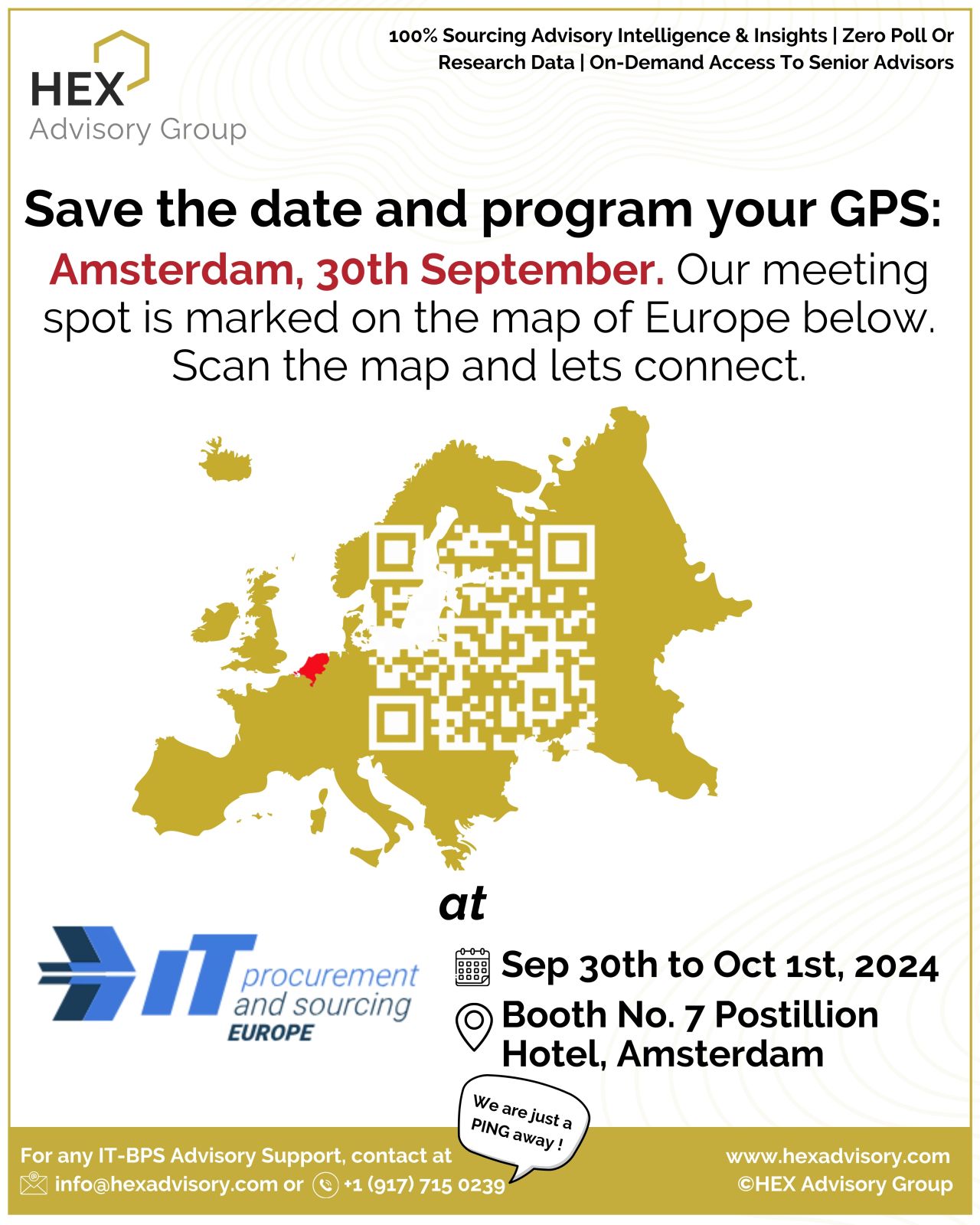Anyone can rubberstamp your plan. We’d rather pressure-test it.
That’s how real outcomes are born.

Source: LinkedIn
Anyone can rubberstamp your plan. We’d rather pressure-test it.
That’s how real outcomes are born.

Source: LinkedIn
In sourcing, theory doesn’t cut it, callused hands do.
This year, HEX delivered 40–60% efficiencies across:
/ AI-first SmartDesk
/ ITAMaaS
/ Agentic SAP S/4HANA
/ GCC TOM, Scoping, Business Case, Real Estate & Govt liaisoning, Talent Execution
/ EDGE IoT SOC/NOC Managed Services
ALL from the trenches.
We win large, confidential mandates against Big Consulting for one reason: We know HOW.

Source: LinkedIn
We at HEX are excited to connect with Europe’s top IT procurement and sourcing heads at the IT Procurement & Sourcing Summit 2024 in Amsterdam on . As your trusted sourcing advisors, we bring 100% data-driven insights, powered by our proprietary ™ —an invaluable tool for benchmarking decisions based on over a decade of real transaction data.
Don’t miss the opportunity to discuss how we can drive your IT procurement strategies forward. , fill out our contact form, and let’s secure some time to discuss how we can support your next big move.
Your future sourcing decisions could be a PING away! We’re just a form away, so lock in your spot and let’s explore how HEX Advisory Group can empower your procurement strategies!

 23
23
While analysts may have you believe that deal sizes increase due to vendor consolidation, we as advisors at HEX are assisting clients first-hand with vendor consolidation mandates targeting 20-25% spend reduction via effort elimination, hyper-automation, right-sizing, right-pricing, and 3rd-party Op-model and contractual transformation.
Anyone can run an RFP dog and pony show with multiple bidders. This is a lazy, long-drawn, expensive, and self-serving way of running a sourcing program. Instead, HEX Advisory Group has the chops to expeditiously secure contemporary solutions, modern contracts, and competitive commercials with any vendor/s by drawing upon its senior practitioners, recent transactions’ benchmarks, and clearly defined end-states.
To know more click here.
During and post-pandemic, Talent is among the most secular agendas across all firms pan industries. And as firms are scrambling to get the appropriate talent onboard, recruitment process operation is the backbone to execute the talent strategy. As a result, recruitment process outsourcing (RPO) industry has been seeing a sharp growth especially post H2 2021.
A combination of factors are in play that influence enterprises to outsource their recruitment processes.

As a result of the increasing complexity of the health plan environment, coordination of payments to multiple parties and a wide range of government and private health plans remains a challenge. Payment Integrity solutions are reducing the rising healthcare waste and fraud to ensure that claims are paid correctly, free of leakages. Using advanced analytics and data mining, patterns are identified across billions of lines of claims to predict errors in claims, thereby helping firms to reduce waste and focus on value-based care for patients.
We see broadly three types of engagement models in the Payment Integrity space:
What you control is governed by the metrics you measure and report on. But are the right metrics being measured? Traditionally, the functional and back-office metrics have been linked to the respective functional areas and the linkage to enterprise objectives, if at all, may not be evident. The Business Level Agreements (BLAs) framework can help fill this vacuum and ensure that the reported metrics are linked to the business priorities.
Some of the typical BLAs used in F&A processes:
A well thought out set of BLAs is a great mechanism for the support functions (and service providers) to see their impact on the business and the other way round. Enterprises are increasingly embedding these in the contracts to drive risk-sharing and partnership behaviours.
This is an output-based pricing model wherein the fees structure is based on the transactions / Resource Units (RUs) handled. Buyers should consider this model in the following scenarios:
SD-WAN allows for more agile ways of working and improves site availability through simplified and faster failover and relocation of traffic. It helps optimize costs as once implemented, it allows for better aligned demand and supply model to reduce underutilised assets and increase efficiencies as well as utilise a range of cheaper underlying connectivity.

While it offers benefits of technology-agnostic overlay and dynamic routing, without a clear strategy and transformation plan, many of the SD-WAN benefits can be limited or lost such as the ability to consolidate multiple network functions in a single platform.
Virtual captives are increasingly becoming an acceptable solution as they occupy a median position in a spectrum that is occupied by third party outsourcing on one end and captives on the other. For the mid-market enterprises, who end up experiencing a ‘small-fish’ syndrome with large third-party providers and captive remains a pipedream due to lack of capital/appetite, virtual captive offers best of both worlds. It is essentially a hybrid model wherein a local provider will provide all the necessary infrastructure (managed facility, hardware, connectivity etc), talent (sourcing, recruitment & HR), compliance and support services (accounting, compliance, IT operations) while letting the client retain full control of the operations.
Some of the specific advantages this sourcing model offers
The heated demand is leading to a drive for talent thereby heating up the salaries in onshore and offshore geographies – thereby increasing the cost to serve for Consulting service providers by as much as 10%-20% on a fully-loaded op-cost per FTE basis depending on the underlying technology type and resource seniority. However, enterprises remain cautious and price sensitive on consulting spend and >80% of consulting engagements have some form or fashion of line-of-sight into tangible outcomes / impact.
Currently, the preferred pricing models for S&C are fixed fee based for clearly ring-fenced scope, outcomes, timelines, and with contractual flexibility to pause and/or terminate. Enterprises are also open to risk-gain share mechanisms BUT should be tread with utmost clarity and thought on scope due-diligence, underlying assumptions, dependencies, and outcome versus risk thresholds, else can be detrimental to an already diminishing margin turf for service providers.
Since the cost to serve for S&C is expected to remain elevated in the near to medium term, this segment of business is expected to see margin pressure. A negative margin scenario is only to be expected if providers do not push for a well-defined scope or outcomes, do not size/solution the effort and staffing accurately, or undercut strategically or competitively for downstream execution-led gains. Opportunistically leveraging the perceived ‘premium and niche skills’ market can offer consulting providers with some margin-cushion at a deal-level.
The mega deals market (>$100M TCV) is shrinking. In general, enterprises are reconsidering large scale transformation investments, breaking down larger programs and staggering them over budget cycles based on priority or predictable RoI. Exceptions may be seen in the Telecom, Transportation, Utilities, Mining, and Energy verticals spurred by the infrastructure spending bill.
Small to mid-sized deals market ($5M – $15M ACV) will continue to see momentum driven by bite-sized initiatives, cost and operations focused mandates, and mid-cap enterprises coming out of the woodwork to sustain their business in a tightening liquidity market. Nearly 60% of new deal value is expected in this segment.
Providers will need to reevaluate their sales strategy – do they invest resources in chasing the few large deals involving long spin cycles or get better at closing smaller deals with shorter spin cycles.